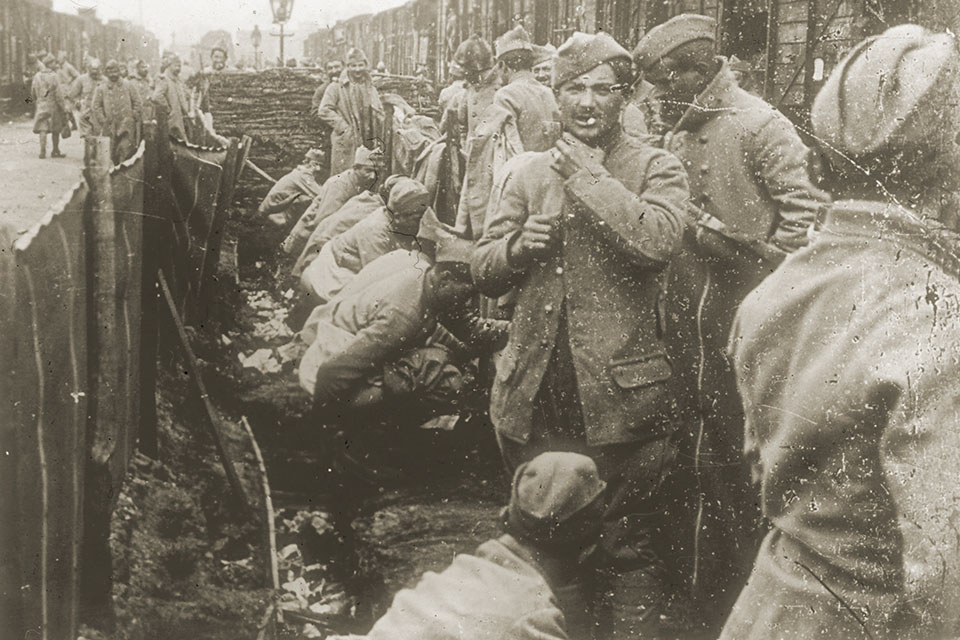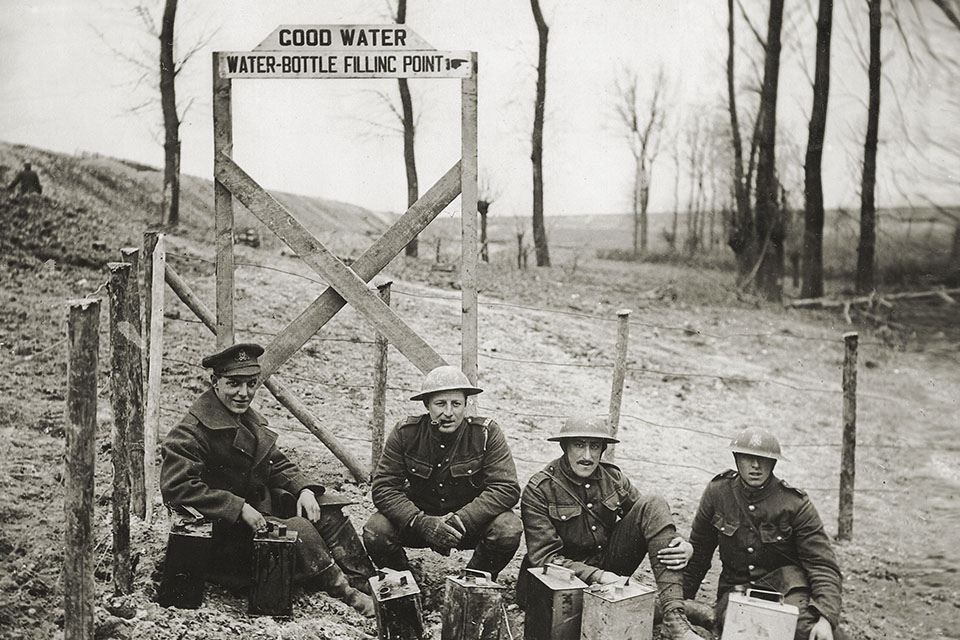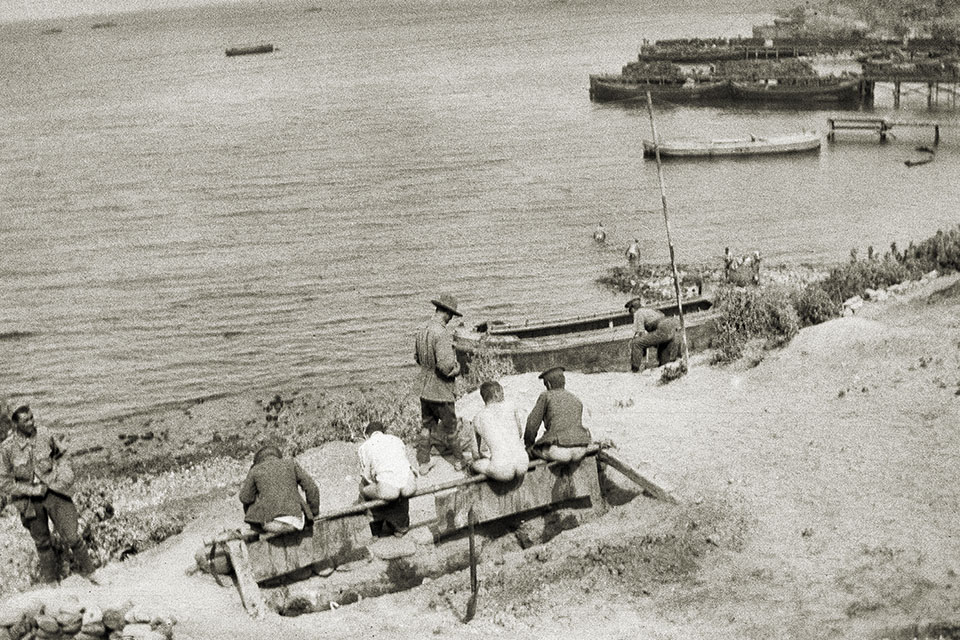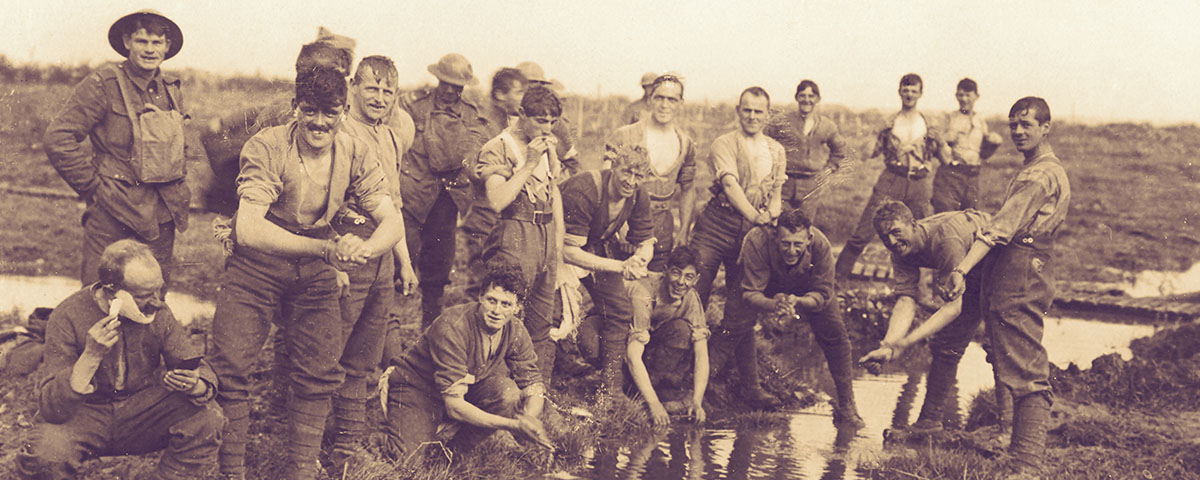Lethal diseases have ravaged militaries across the millennia. Enemy No. 1: poor sanitation.
IN MOST OF THE ERAS RECORDED BY MILITARY HISTORY, it was a reliable truism that an army could lose more men to disease than to the lethal efforts of its enemies. Diseases, particularly those of the insect-borne or water-specific types, have been responsible for untold millions of deaths in militaries across the millennia. Ironically, armies ravaged by disease have usually carried the seeds of their destruction with them in the form of poor field sanitation habits. After all, a sufficiently provisioned army of 10,000 men could produce about four tons of fecal waste every day; without adequate latrine facilities carefully situated away from water sources and field kitchens, it would only be a matter of time before debilitating, deadly diseases began rampaging through the ranks. In light of this, there is good reason to argue that the humble latrine was every bit as important to the waging of a successful military campaign as were good artillery, logistic support, sufficient ammunition, and well-trained troops.
Today in the U.S. Army, protecting soldiers from disease vectors is such a command priority that field sanitation doctrine is taught and enforced at all levels of military training and in every unit. Effective sanitation policies are a fairly modern development, however, gaining official acceptance and emphasis only after the inexcusable losses of the Civil War and Spanish-American War. Military traditionalists stubbornly resisted change. While medical officers argued for improved sanitation practices, tactical commanders did not always share their concerns or understand the relevant science, often with drastic consequences. As a military surgeon who served as a sanitary commissioner in the British Army in India wrote in 1868, “The recommendations of Medical Officers did not always meet with the attention they now do.” For the British Army, the dangers of such willful disregard were demonstrated all too clearly during the Crimean War—according to official sources, it lost 25 times as many men to disease as to enemy action during that conflict.
The importance of a reliable water supply and efficient field sanitation have always been recognized, to varying degrees, and no commander worth his rank has ever willfully ignored those necessities, especially if his army occupied a static position. Without proper precautions, a force that was stationary for more than a few days was at great risk of decimation from disease. The presence of too many men in a limited space could quickly turn a military encampment into a pestilential fever-zone, and no one disputed that. In the centuries before germ theory finally gained acceptance, however, the problems that inevitably developed when good sanitation was ignored were not as clearly understood. The greatest threats were cholera, typhus (after it made its first appearance around 1450), cryptosporidiosis, and dysentery in both its amoebic and bacillary forms.
Cautionary examples of the threat arising from poor sanitation abounded. Nearly a third of the population of Athens reportedly died of typhoid over a six-year period beginning in 430 BCE, an epidemic that brought down the state. Henry V’s famous victory at Agincourt in 1415 was all the more noteworthy because dysentery had killed or invalided as much as a fifth of his army during the earlier siege of Harfleur. Dysentery was such a recurring problem in siege warfare during the medieval period that it was called “the siege disease,” or “the bloody flux,” and it was rightly feared for its high mortality rate. In fact, Henry V himself died of the disease following the Siege of Meaux in 1422.

Coming into the modern era, as many as two-thirds of all deaths during the American Civil War were caused by disease rather than battle. The most lethal disease among some segments of the military population was the soldier’s age-old nemesis of diarrhea, which accounted for up to a fifth of all noncombat deaths. The Spanish-American War marked a notorious nadir in the history of the U.S. Army—deaths from disease in the training camps eclipsed actual combat deaths nearly seven to one. Unchecked disease has always been the great destroyer of armies, and most instances of disease in military situations originated from the prosaic problem of how to deal with human waste.
SOLDIERS THEMSELVES HAVE ALWAYS DISCUSSED THIS ASPECT OF WARFARE with more direct and unembellished language than have most historians. Soldiers are accustomed to rough living, but this facet of military life mattered because of how much it often added to their miseries. What was usually a simple and private function in normal life became, in combat conditions, a difficult, very public, and sometimes extremely dangerous activity. Soldiers cursed it, laughed about it, made coarse jokes about it, and even wrote poems about it, but no one ever forgot what it was like to live for weeks or months without a serviceable latrine. In soldier narratives from 1800 to 1945, the topic arises in all eras, in all armies, in every conflict.
The Italian Campaign of World War II was notorious for hard combat in rugged conditions. Monte Cassino was a terrible place to fight. Rocky terrain prevented the digging of fighting positions or trenches below ground level; the only cover that could be constructed was in the form of sangars, fortified positions made from walls of rock and stones. Even these were shelters of dubious efficacy, since German artillery had registered the approaches to the mountain so accurately that daylight movement was impossible without drawing immediate and effective fire.
“We were many times better off than the battalion directly facing the monastery, where throwing the contents of his lavatory tin out of the back of his sangar earned many a man a hail of mortar bombs,” a British soldier of the Irish Guards who fought at Monte Cassino remembered. “Just try sharing a rock hole about the size of two coffins with three others, then, in a prone position, lower your costume and fill a small tin held in the hand. The stink of excrement competed with the smell of death in every position. Bowels will not wait for nightfall.”
In frontline conditions where artillery and direct small-arms fire were constant threats, a man who left his hole or trench to relieve himself might not live long enough to pull his trousers back up. As a British NCO noted in his sector of trench in France in 1915, “to get up…in daylight would be, well, asking for the Huns to put daylight into one.” Men quickly got over their inhibitions or suffered the fate of the narrator in Kipling’s poem, The Refined Man: “I was of delicate mind. I stepped aside for my needs, / Disdaining the common office. I was seen from afar and killed.…”
A British lieutenant in the Devonshire Regiment, who fought in the muddy horror of Passchendaele in 1917, described the wretched and inadvertently egalitarian conditions of living for weeks in a hole in the ground with other men. “If, for instance, you wanted to urinate and otherwise,” he said, “there was an empty bully beef tin kept on the side of the hole, so you had to do it in front of all your men [and] then chuck the contents, but not the tin, over the back.”
In Passchendaele’s primitive conditions, where the combatants lived in mud-filled shell-holes (it was impossible to dig conventional trenches in the water-logged ground), men could not leave their positions when they were racked by attacks of diarrhea. Soldiers defecated in their bully beef tins and threw the liquid waste over the rim of their hole. “The men were hardened, but the life was terrible,” the Devonshire lieutenant remembered. “Another extra chore was that lime had to be spread on the back of the posts because open excreta was being chucked out and if you didn’t put down lime then when you came crawling out you’d be covered in it.” Diarrhea was rampant in the British ranks, most often because drinking water had been fouled by any number of contaminants.
The battlefields of World War I, in fact, were a nightmare for potable water. Units went into the trenches in rotation, and for the days or weeks that they were on the lines the only water resupply they received was what could be sent forward to them under cover of darkness. When that failed, they drank whatever water was at hand. That was always an option of last resort, but desperation would brook no fastidiousness. “The water we had to drink,” one soldier wrote in his diary when he was fighting in the vicinity of Hill 60, “was from a stagnant pond, the drainings from the ditches.” That was bad enough, he remembered, but there was an even worse postscript. A few days later he wrote, “We discovered a dead pig in our water pond.”

The monthslong fighting on the Somme in 1916 made simple things hard when it came to logistics and hard things sometimes nearly impossible. “There was only one place in the Somme where drinking water could be obtained,” an Australian soldier named Hugh Knyvett wrote. “The Germans…made it very difficult for us to get at it by shelling continually. They had the exact range, and it was only in the hour before dawn that one could get near the wells without meeting certain death.” Knyvett did not relish the prospect of dodging German artillery fire to get water, but there was no real alternative. “Of course, there was plenty of other water filling every hole around,” he remembered, “but this was not only thick with mud but had the germs of gas gangrene, and one knows not how many other diseases besides.” (Also known as “clostridial myonecrosis,” gas gangrene is a bacteria-caused infection that gives off a foul-smelling gas in the afflicted tissue, hence the name.) Another man who had fought at Passchendaele recalled its muddy horror years afterward: “We were so thirsty that we actually drank water out of shell-holes, and God knows what a shell-hole contains. It could hold anything—very often parts of a human body. But we were so thirsty we drank it cold and without boiling it, because you couldn’t get a fire very often.”
Even in conditions as difficult as the trenches of World War I, armies tried to push rations and water forward to the men in the lines, but many British soldiers complained that although tea was sent forward every day, it came in two-gallon petrol cans, each carrying with it its own malady. “Well, those tins were baked, boiled—everything was done to them—but whenever you put a hot substance in them you still got petrol oozing out, and that gave the men violent diarrhea,” one soldier wrote. “But they had to drink it because it was the only hot drink they had.” For the men on the line, it was just one more element of misery in a situation that quickly exceeded all known bounds of misery. Still, some men found a bleak humor in their gasoline-tainted water. “There was a standing joke,” another British soldier recalled, “that if you were out there long enough you could tell the difference in taste as to whether the water came in a British Petroleum or a Shell can.”
AS VITAL AS CLEAN WATER IS TO AN ARMY’S HEALTH, most militaries as late as the early 20th century still failed to adequately provide dedicated containers for water resupply. The problems inherent in contaminated water were clearly identified and understood, but for whatever reason there was little standardized military response to the issue, even during World War II. U.S. Marines fighting in the sweltering heat and dust of Peleliu in the Palau Islands suffered the same physical ailments as had their predecessors at Passchendaele when water came in five-gallon cans that had previously held diesel fuel. No amount of cleaning and no method of scouring ever seemed to completely rid the cans of the fuel residue, and desperately dehydrated men drank the contaminated water knowing it would make them violently ill. Owing to the lack of foresight on the part of the logistics and supply chain, they had no other choice.
The prevalence of diarrhea in the field made proper latrine facilities all the more crucial, but in forward positions those essential stations were almost never adequate, either in terms of sanitation or security. Even rear areas of the front were not entirely safe if they were still within range of the enemy’s guns—artillery shells made no concessions for those moments when a man might be indisposed by a call of nature. A British officer recalled seeing a random German shell score a direct hit on the officers’ latrine in the artillery lines in France in 1915. “I was shocked to see a man still sitting there on the throne, and I thought he must be dead,” he wrote. “I ran as hard as I could and arrived to find [him] up and adjusting his trousers. He said with a grin, ‘It was lucky that the shell came when it did as I was feeling a bit constipated.’ ” It was not the first time shellfire could have been said to have loosened a man’s bowels, but in that case, it at least happened in a convenient setting.
Ernst Junger, who commanded an infantry company in the German army during World War I, described the latrine that was positioned behind his unit’s trench as being particularly vulnerable to enemy fire. At times, he wrote, “stray bullets from all directions seemed to have arranged a rendezvous for themselves at the latrine, so that we were often compelled to flee, holding a newspaper and trousers at half-mast. And for all that, it seemed not to have occurred to anyone to move this indispensable facility to a place of greater safety.”
The height of battle is, of course, an especially bad time to be stricken with diarrhea. During the Battle of Talavera in the Peninsular War in 1809, with both sides heavily engaged and the fighting well underway, a British officer found himself in just such a situation. As the commander of an artillery battery under heavy fire, he felt he could not go to the rear to relieve himself lest his men think he was trying to escape the ferocious cannonade of the French guns. Rather than going behind his battery, then, he “deliberately walked a hundred yards or so in front of the brigade, and disembarrassing himself of part of his clothing, yielded to the irresistible necessity of the case, after readjusting his dress, and calmly putting on his sword and sash, he returned leisurely to his post. The transaction excited a great deal of mirth, notwithstanding the heat of the action.” His insouciance solicited no small amount of admiration, as did the fact that he somehow survived.
THE ADVENT OF MECHANIZED WARFARE ADDED ITS OWN COMPLICATIONS to the requirements of human physiology. Tanks, after all, do not have toilets. As a New Zealand tank commander recalled of the fighting in Italy in 1943, “It was difficult to sort of carry out the demands of nature when you were in the tank all day, and so when you thought you [were] required to do something you put a shell up the spout, shoot off at something, wait until the shell case cooled down, and then you used it for a toilet and you put it out through the little hatch.”
The disease vectors of bacteria and vermin were exacerbated when a static battlefield was sweltering in hot weather. The fighting at Gallipoli in 1915 was never marked by the mud and cold that other campaigns of that war were notorious for; rather, it was a hellish environment of heat and dust and flies—flies on a biblical scale, reminiscent of the fourth plague of Egypt. The flies—the result of the human excrement and rotting corpses that littered the contested battleground—covered everything: the ground, equipment, food, and the men themselves. “One of the biggest curses was flies,” one soldier said of Gallipoli. “Millions and millions of flies. The whole side of the trench used to be one black swarming mass. Anything you opened, like a tin of bully, would be swarming with flies….They were all around your mouth and on any cuts or sores that you’d got, which then turned septic.”
“There were more flies on the [Gallipoli] Peninsula than there was sand on the shore, and they fought us persistently for every atom of food,” another Australian soldier wrote. “Getting a meal was a hard day’s work, for all the time you had to fight away the swarms, and no matter how quick you were with your fork, you rarely got a mouthful that hadn’t been well walked over, and it didn’t do to think where those flies had been walking just previously.” The flies laid eggs, which quickly hatched into maggots that infested the floors of the trenches where rotting corpses were covered by only an inch or two of dirt. “We lived in a headquarters of maggots—pale, wriggling, stinking, blasted things,” another soldier wrote. Another soldier who endured Gallipoli wrote: “Maggots are falling into the trench now. They are not the squashy yellow ones; they are big brown hairy ones.”

The flies feeding on decomposing corpses and human excrement spread a virulent form of diarrhea that troops called “the Gallipoli Trots” or “the Gallipoli Gallop.” As more and more men came down with dysentery, the slit latrines, already inadequate and overused, became a stinking horror. “If you’d looked in the latrines you’d have been sickened,” a British soldier said. “You’d think people had parted with their stomach or their insides. It was awful.”
Soldiers who fought the jungle campaigns in Burma, the Philippines, New Guinea, and other battlefields of the Pacific Theater in World War II were frequently ravaged by malaria, dengue fever, and other mosquito-borne diseases, but they also suffered from the full range of gastrointestinal ailments such as amoebic dysentery and cholera. When possible, sick men were sent to the rear, but in some situations medical evacuation was simply not an option. It was not an uncommon thing to see wasted, exhausted men still carrying their weapons and still in the fight, but with the seats cut out of their uniform trousers because they were stricken with nearly uncontrollable diarrhea.
Similar expedients were adopted in the previous century during the retreat of Napoleon’s Grande Armée from Moscow in 1812. The extreme cold of the Russian winter made the act of defecation extremely difficult, so men resorted to cutting open the seams of the backs of their trousers in order to be able to defecate without having to lower their breeches. Those who did not adopt this expediency sometimes found themselves in a terrible predicament. “Men who walked to the side of the road and unbuttoned their pants in order to answer the call of nature, a frequent one since many of them had diarrhea, would find to their horror that they were unable to button them up again,” Adam Zamoyski writes in 1812: Napoleon’s Fatal March on Moscow, his masterful account of the campaign. A French officer remembered seeing several soldiers and officers who could not button themselves up because of their freezing fingers. “I myself helped to dress and button up one of these unfortunates, who was weeping like a child,” he wrote.
German soldiers on the Eastern Front in World War II also found that the normally simple act of relieving oneself could be almost impossibly difficult in Russia’s bitter cold. Frost-numbed fingers could barely manipulate buttons, even partially divesting oneself of the necessary layers of clothing that kept one from freezing to death made every bowel movement an exhausting process, and exposed flesh froze unbelievably quickly. That reality continues to this day in certain climates, and more than one modern soldier, after months in the field, has listed a flushable toilet in a warm room as one of life’s greatest luxuries.
RECOGNIZING THE IMPORTANCE OF FIELD SANITATION, modern armies at the end of the 19th century began standardizing their health doctrines to address the need for proper latrine facilities. In 1918 the U.S. Army admonished its officers that any commander “who does not give this subject the proper attention must necessarily be a failure.” To that end, direction was given on the construction and use of latrine facilities in a variety of tactical environments. These ranged from the simple straddle trench to temporary box latrines with burn-out pits intended for longer use, as well as more permanent facilities designed to serve a large encampment. The danger of cross-contamination by flies and the risks to water sources was clearly understood, and much of the medical guidance was directed at controlling those specific risks. These measures were largely effective and when coupled with the advent of antibiotics were directly responsible for the decline in disease-related deaths during the wars of the 20th century. Yet officially mandated and medically prescribed practices were often not possible in the maelstrom of the battlefield, and in those situations soldiers simply endured as best they could.
The great military campaigns of history have succeeded or failed for many reasons, but often overlooked in all the important details of strategy, logistics, maneuver, and battle there remain the mundane but absolutely vital necessities of clean water and well-planned latrines. Armies that ignored those two essentials frequently found they had created an adversary more dangerous than any enemy that faced them across the field. MHQ
John A. Haymond is the author of Soldiers: A Global History of the Fighting Man, 1800–1945 (Stackpole Books, 2018), from which this article is adapted.
[hr]
This article appears in the Spring 2019 issue (Vol. 31, No. 3) of MHQ—The Quarterly Journal of Military History with the headline: The Waste of War

Want to have the lavishly illustrated, premium-quality print edition of MHQ delivered directly to you four times a year? Subscribe now at special savings!

